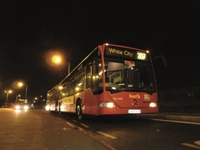
Driver of first and last bendy bus sees the Citaro artics bow out
Matthew Wooll, revenue and marketing manager at First Berkshire, drove the last ever bendy bus service in London on its 207 operation, which ended in the early hours of Saturday, December 10. “The last journey to depart was driven by myself from Hayes By-Pass (arriving at White City at 0054hrs), although due to a significant difference in directional running time, the last bus to actually still be in passenger service was the final journey from White City to Hayes By-Pass (which arrived after 0100),” Matthew told CBW.
“I also drove the first 207 bendy bus on October 15, 2001 (the first day of the six-month trial), which followed a brief trial over nine years earlier at Selkent.”
Articulated buses were introduced to London when former mayor, Ken Livingstone, introduced new Mercedes-Benz Citaros to Red Arrow routes 507 and 521.
Bendy buses have had very mixed and strong reactions – fans praised their ability to move huge numbers of people while enemies criticised them for levels of fare evasion, threat to cyclists, catching fire and for blocking roads. Johnson once described them as “jack-knifing, traffic-blocking, self-combusting cyclist crushers.” As part of his mayoral campaign in 2007, he pledged to withdraw them and introduce a modern replacement Routemaster.
In 2009, the first three bendy bus routes were replaced with conventional lowfloor single and double deckers. Of the 350-strong fleet of bendys running on 12 routes, 500 new buses have replaced them, including 50 hybrids. The New Bus for London (NBfL), dubbed the Borismaster, enters service in 2012. Transport for London (TfL) estimates the switch will save £7m per year due to a reduction in fare evasion.
TfL said it reviewed service patterns on the 12 converted routes to ensure they continue to meet demand, each of which has seen an increase in Peak Vehicle Requirement (PVR).
“Today we bid a final but not fond farewell to the bendy bus,” said the mayor on the last day of service. “These bulky and ungainly monstrosities were always more suitable for the wide open vistas of a Scandinavian airport than for London’s narrow streets and I am glad to see the back of them. While it is goodbye to the bendy it is hello to the svelte and elegant NBfL, which will grace the capital’s streets from early next year.”
Stephen Morris of Bus Users UK spoke to Radio 4 on Thursday, in support of bendy buses. Asked what was so great about them Stephen said: “They are perfect for shifting large crowds. The greatest application was running services between Victoria and Waterloo, and Waterloo and the City. You’d get off the train at Waterloo and there would be a huge queue for the bus and you’d think ‘I’m going to be here for ages’ and you’d walk straight onto a bendy bus and away it goes.
“They are absolutely great crowd shifters – better than any bus I’ve come across,” concluded Stephen.
Noel Staples, a retired London bus driver, gave his perspective as someone who drove the 24 route, following bendy buses along Tottenham Court Road, down from Mornington Crescent towards Trafalgar Square. “The big problem is they obscure the bus stops completely and you can sometimes have two, in this case the number 29, on the same bus stop and although they set down and pick up very quickly indeed, if I can’t see the bus stop and if I haven’t any passenger to get off at that bus stop, I still have to pull up and wait in case there are any passengers to get on.”
Asked if bendys were more trouble than they were worth, Noel said: “They were excellent crowd shifters but they allowed an awful amount of fare-dodging.”
Noel said he would often be held up at Mornington Crescent waiting while Police officers would stop bendys, blocking each exit and check everyone for fare dodgers. “19 sets of traffic lights on one stretch of the route also proved a problem,” he added.
Stephen responded: “One thing which irks me about Boris’s decision was an awful lot of money was spent to make bendy buses work in London. They rebuilt Victoria station, modified countless stops and moved street furniture at vast expense. They worked in London a lot better than in other cities as a result and now we’re just forgetting about the money that was invested and saying ‘that’s okay we’ll just write it off’ – I think it’s absolutely criminal.”


